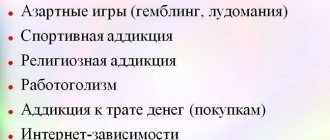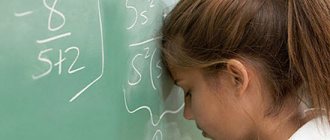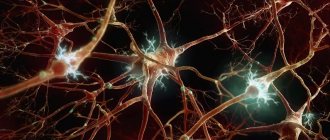Lebedeva E.N., children's speech therapist, speech pathologist-defectologist, Children's Clinic "Markushka"
Dyscalculia is a specific term that recently appeared in our society, and, unfortunately, is unfamiliar even to teachers. What is it, and what do parents, especially those with children – preschoolers and primary schoolchildren, need to know?
Dyscalculia in children
- a specific disorder of mathematical abilities, characterized by the child’s inability to successfully master even the simplest arithmetic functions.
Diagnosis of dyscalculia
Children with this specific disorder are characterized by:
- Difficulty determining and comparing the number of items;
- Difficulties in distinguishing between the concepts “more” and “less” without specific recalculation;
- It is difficult for them to name the sequence of the number series in both forward and reverse order;
- Difficulties arise in remembering the composition of a number, in understanding the semantic significance of arithmetic operations (addition, subtraction, multiplication, division);
- Students have great difficulty memorizing addition and multiplication tables, mathematical terms are incomprehensible, and solving the simplest problems leads to a dead end if there is no visual subject line;
- Errors in writing and naming numbers are also common.
Symptoms of the problem
Children suffering from dyscalculia are not able to understand what a number is and on what principle the number series is built; they cannot distinguish and remember numbers. They cannot perform operations with numerical values and do not know how to decompose them into terms. It is difficult for them to compare the number of objects, perform simple arithmetic operations and carry out calculations according to the internal plan, that is, to count “in their minds”.
Symptoms of dyscalculia:
- difficulty recognizing and writing numbers;
- inability to tell time and navigate hours, minutes, seconds;
- impaired coordination of fine movements;
- inability to determine the distance traveled or measure the length of a segment;
- difficulty in perceiving the concepts “less” and “more”;
- the impossibility of solving problems without illustrative support;
- difficulties in solving logical problems and performing actions with abstract categories;
- inability to visually determine the number of objects, putting them into groups without counting them one by one.
As soon as relatives discover the above symptoms in a child, you should immediately seek advice from a speech therapist or psychotherapist. The specialist will conduct a differential diagnosis, determine the form of the disorder, identify the causes of its occurrence and develop an effective correction method.
Due to a violation in the processing of visual information, the child can solve examples only if their objective component is present. The child cannot independently imagine what is written in the task conditions. In addition, schoolchildren in the primary grades are unable to rationally calculate their free time, which leads to poor academic performance and behavior problems in the future.
Causes of dyscalculia
In studying the causes of such a disorder, scientists agree that the main thing is a disruption in the functioning of the cerebral cortex. This can be either a consequence of mental retardation, mental retardation, or a variant of a genetic hereditary malfunction, as well as a consequence of strong psychotraumatic factors. Impaired functioning of the visual analyzer, impaired processing of received information, difficulties in analytical and synthetic activity can also be the cause of dyscalculia. Therefore, we should talk about dyscalculia proper in cases of intact intelligence, against the background of which difficulties in mastering simple mathematics appear.
Dyscalculia in children can manifest itself independently, or in combination with reading (dyslexia) and writing disorders (dysgraphia).
Types of dysgraphia and dyslexia
Today, experts divide dysgraphia into five main forms, each of which depends on what specific written operation is impaired or not formed:
1. Acoustic dysgraphia - characterized by a violation of phonemic recognition of sounds. With acoustic dysgraphia, there may not be disturbances in the pronunciation of sounds, but their perception will definitely be incorrect. In writing, this manifests itself in the replacement of sounds that a person hears with those that are similar to them when pronounced, for example, whistling sounds are replaced by hissing ones, voiceless sounds are replaced by voiced ones (S-Sh, Z-Z, etc.)
2. Articulatory-acoustic dysgraphia - characterized by a violation of articulation and perception of phonemics (phonemic hearing), as well as difficulties associated specifically with the incorrect pronunciation of sounds. A person writes exactly like this, in sound pronunciation. With articulatory-acoustic dysgraphia, errors in writing are heard. As a rule, such symptoms occur in children whose phonetic-phonemic side of speech is underdeveloped.
By the way, errors with dysgraphia of this type will be similar both in pronunciation and in writing (for example, if a child says “funny zayas,” he will write in exactly the same way).
3. Agrammatic dysgraphia – characterized by problems in lexical development and the development of the grammatical structure of speech. With agrammatic dysgraphia, words are changed by case, declensions are confused, the child is not able to determine the number and gender (for example, “bright sun”, “good aunt”, “three bears”, etc.). Sentences are characterized by inconsistency in word placement; some sentence members may even be omitted altogether. As for speech, it is inhibited and underdeveloped.
4. Optical dysgraphia – characterized by undeveloped visual-spatial perception. In optical dysgraphia, letters are mixed up and replaced with those that are visually similar to the correct ones. Here it is necessary to distinguish between literal optical dysgraphia (isolated letters are incorrectly reproduced) and verbal optical dysgraphia (letters in words are incorrectly reproduced). Most often, letters are “mirrored”, unnecessary elements are added to them or the necessary ones are not added (for example, T is written as P, L as M, A as D), etc.)
5. A special form of dysgraphia, caused by the immaturity of language analysis and synthesis. With this type of dysgraphia, the child changes letters and syllables in places, does not complete the endings of words or adds extra ones, writes prepositions together with words, and separates prefixes from them (for example, “on the table,” “on the table,” etc.). This type of dysgraphia is considered the most common among schoolchildren.
In practice, any type of dysgraphia in its pure form is quite rare, because in most cases, dysgraphia takes a mixed form, but with a predominance of one type.
Prevention of dysgraphia and dyslexia involves certain actions even before your child learns to write. They include exercises for the development of attention, memory, thinking, spatial perception, visual and auditory differentiation and other processes responsible for mastering the skill of writing.
Any, even the most minor, speech disorders must be corrected immediately. It is equally important to expand a child’s vocabulary. At an older age, you need to train your handwriting.
Classification of dyscalculia
At the moment, several types of dyscalculia are known, each of which has its own characteristic signs. But as practice shows, the “pure” type is extremely rare, so the diagnosis of dyscalculia should be carried out by a specialist who, during the examination, will be able to see the whole picture.
In modern correctional pedagogy and psychology, graphic, verbal, lexical (numerical), operational, practical-gnostic and spatial dyscalculia are distinguished, as well as arithmeria (inability to master the calculation process) and pseudodyscalculia (underdevelopment of mathematical abilities due to lack of desire to learn, lagging behind in the curriculum or incorrect training program, when assignments are not based on the material covered).
Dyscalculia in schoolchildren. Most common types
| Type of dyscalculia | Characteristic |
| Graphic | Characterized by a violation of “coding”. Difficulties arise when writing the named number, errors in determining the grapheme related to the spoken number or the named mathematical term. Inability to graphically indicate a geometric figure written in a problem or spoken aloud in a verbal formulation. |
| Verbal | Characterized by difficulties in naming numbers, symbols, quantities, reading formulas and mathematical operations. |
| Practognostic | Inability to abstractly count objects, distribute them depending on quantity, shape or other characteristics in a given order. |
| Lexical | Lack of understanding of arithmetic functions, inability to solve mathematical examples or equations as a result of unawareness of operations with symbols, violations of spatial-visual processes. |
Games and tips for a confirmed diagnosis
An important component of success when teaching a child with a similar disorder is positive motivation. And family support plays an important role in the learning process, because it is among close people that the child receives emotional support and learns to work hard. The main rule is to give it time to understand, even if the task seems very simple to you.
- Culinary . Counting training and “communication” with numbers should become an integral part of life, so it is important to apply it in different aspects. Kids can be involved in the process of preparing the recipe. The baby’s task will be to prepare the required amount of ingredients (3 carrots, 5 potatoes). This is also true for going to the store. Let your child count and put 2 packs of pasta and 5 yoghurts into the basket. For older children, you can make it more difficult by adding prices. He must find out which yogurt is the most profitable to buy, etc. Ask the child to set the table with the expectation that he will have to count the required number of guests, forks, spoons and other utensils on the table.
- Watchmaker . Try to keep your baby occupied for hours, let him start watching a cartoon or treats at a certain time. Ask him what time it is or when you should leave the house. Reward your child with the position of “time keeper” and reinforce the importance of this event.
- Counting non-stop . A great practice is to count the objects around you. When going for a walk, a child can count people, cars or entrances passing by. A game of searching for certain numbers will be productive. During a walk, a child can look for the number 3 on everything that surrounds him.
In this simple way, you will motivate your child to pay attention to the numbers and interact with them, which will help reduce his level of discomfort and tension. But without professional help, it is difficult to achieve the necessary adjustment, and the sooner you contact a speech therapist, the easier it will be for the child in the future.
Publication date: 08/17/2021. Last modified: 11/19/2021.
Correction of dyscalculia
Corrective work to overcome dyscalculia should be carried out under the guidance of specialists. It is best when several specialists work with the child at once: a defectologist, a speech therapist, a psychologist, a neuropsychiatrist. Due to little knowledge of this disorder, most often all the work falls on the shoulders of a speech therapist or speech pathologist.
The developed speech therapy and defectology programs include a set of classes aimed at developing specialized mathematical actions and general life concepts, such as: more and less, number composition, mental counting, with the subsequent transition of actions into skills.
Particular attention is paid to the development of thinking, the formation of abstract thinking. At the same time, a program for speech development is being built to expand the vocabulary of children, and the ability to verbally compare, analyze and contrast is being taught.
Timely and complete classes for the correction of dyscalculia
allow you to successfully overcome this disorder, which helps to improve schoolchildren’s performance in mathematics and improve the child’s psychological state.
Prevention
Prevention of dyscalculia is relevant only when it comes to an acquired disorder. Classes to strengthen numeracy skills can be conducted both in various institutions aimed at child development and at home.
There are a lot of different methods and materials for studying mathematical representation and the general intellectual development of a child. Research shows that with a properly selected program, a child quite easily masters the principle of solving mathematical problems, which means he is not at risk of dyscalculia.
In the case of congenital dyscalculia, correction and training with a specialist is necessary who can build new neuropsychic connections in the child’s brain.
Treatment
Photo: onnispb.ru
Treatment of dyscalculia is carried out during psychocorrection work. The training program includes exercises that stimulate the activation of old and the formation of new neural connections in the areas of the brain responsible for counting, perceiving and distinguishing mathematical symbols, and assessing relationships between objects. The work focuses on developing the following skills:
- Spatial functions . Children are taught to navigate in space, recognize concepts related to size and direction, and determine where the left and right sides are. During the exercises, patients establish relationships between real objects and images of objects, learn the location and direction of movement of objects.
- Speech . At the initial stage, children are taught basic mathematical terms and concepts related to arithmetic operations. Then they move on to exercises on classifying objects, learning to count, and freely using numbers in conversation.
- Basics of Arithmetic . Students master basic mathematical operations, learn to reproduce them in various modalities: in oral speech, in the process of writing, when using objects. The specialist helps them master all stages of the solution, from understanding the meaning of the problem to choosing the calculation logic and its practical implementation. The division of a whole into parts and its reassembly from elements is studied. The skill of writing numbers and other mathematical symbols is strengthened.
Acalculia
Acalculia is divided into primary and secondary. In primary, the parieto-occipital lobe of the brain responsible for spatio-temporal orientation is affected. At the same time, the very concept of number as an independent abstract structure disintegrates. The main difference between primary acalculia is that other areas of the brain are not damaged. With secondary acalculia, the area responsible for counting abilities functions normally, but counting is impossible or difficult due to disturbances in other parts of the brain. In such situations, optic and frontal secondary acalculia are distinguished. With optical, the “recognition” of the number is impaired; the patient cannot recognize the number by its image or name. With frontal, a person cannot perform counting operations due to a violation of brain functions such as selectivity and purposefulness. At the same time, automated calculation is preserved, but a person is not able to maintain longer sequences of actions to solve complex problems.
Clinical manifestations
The first signs of a disorder are identified in preschool age, during the period of formation of the first mathematical skills. Most often, the disease is diagnosed in primary school, when the study of arithmetic begins. The prevalence in schoolchildren can reach 5%. In the absence of professional help, dyscalculia leads to disruptions in the learning process and subsequent choice of specialties not related to arithmetic.
In the preschool period, children learn the concept of “numbers” for a long time and cannot list them freely. There is an inability to compare two objects by size, number of parts, as well as written representation of abstract quantities. In some variants of dyscalculia, a person cannot recognize mathematical symbols, for example, he believes that the written number “5” and the word “five” are two different concepts.
If the clinical picture of dysgraphia predominates, the preschooler cannot correctly write down or rewrite numbers. This is especially noticeable when working with similar symbols: 3, 8, 6 and 9. Children write them upside down or depict them mirrored upside down. The verbal variant of the disorder manifests itself in the inability to correctly represent mathematical symbols when writing them under dictation.
Symptoms of dyscalculia intensify during primary school years. Schoolchildren must learn basic mathematical operations, keep problem solving algorithms in mind, and reproduce and practice complex abstract constructions, such as the multiplication table. When communicating with a child, his inability to translate the conditions of the problem and logical constructions into mathematical notations is noted. It is typical to use visual objects (fingers, pencils, etc.) to carry out calculations. If a person has impaired perception of arithmetic structures, he cannot master multiplication by a column and division by a corner, which require the exact arrangement of numbers.
In the absence of correction during further training, difficulties are observed in mastering geometry, algebra and other exact sciences, where it is necessary to use abstract mathematical symbols. Against the backdrop of these difficulties with learning and perceiving mathematical information, children cannot navigate using maps or carry out calculations related to dates and specific times.
Main characteristics of the violation
This specific disorder in medicine is often considered a childhood disorder, as it is diagnosed at an early age. There is a separate classification of pathology, which helps to more accurately determine the patient’s condition during diagnosis.
Description
The term dyscalculia itself stands for the inability (impossibility) to count, which absolutely accurately characterizes the condition.
The International Classification of Diseases classifies this pathology as a specific disorder of the development of learning skills. Among children aged 5 to 10 years, the disorder occurs in 6%. Peak detection of the condition occurs between ages 7 and 12, when the most intensive learning occurs and the problem becomes apparent.
Important! Both sexes suffer equally from this pathology.
The patient may suffer from a complete inability to learn mathematics or from only a partial disability in which he finds it extremely difficult to master a certain operation. In preschoolers, the condition manifests itself quite clearly in that the child begins to identify geometric shapes later than his peers.
While studying, the patient suffers from the fact that he begins to lag behind his classmates not only in mathematics, but also in all subjects that require mathematical operations.
Dyslexia - what is this disease?











